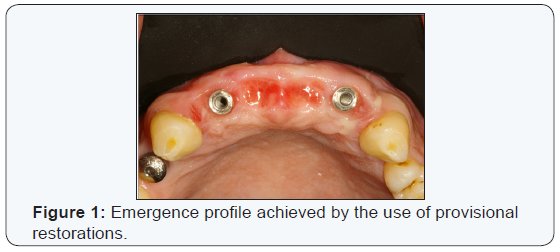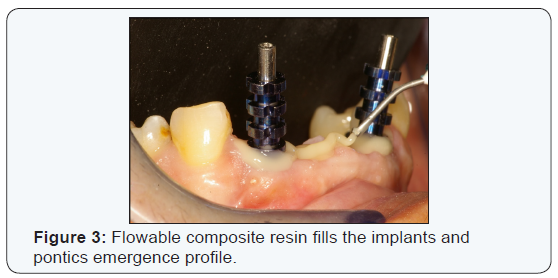Direct Transference of Emergence Profile in Implant Supported Fixed Bridges- Juniper Publishers
Juniper Publishers-Open Access Journal of Dentistry & Oral Health
Abstract
An implant restoration in the anterior area requires
careful management of soft and hard tissues due to biological,
functional and aesthetics requisites. The use of provisional
restorations is necessary to create a proper emergence profile and mimic
the natural dentition and their supporting gingival tissues. It also
contributes to the health of peri-implant tissues and facilitates to
perform a correct oral hygiene. Transferring the shape of the created
emergence profile is key to fabricating the proper final restoration.
This report describes a direct technique to take a final impression of
an implant-supported bridge. Impression abutments and flowable composite
resin were used to fill the gingival emergence profile and obtain a
precise master model cast.
Keywords: Emergence profile; Implant; Pontic; flowable composite resinsIntroduction
The esthetic success of implant supported
restorations is given by the form and health of the surrounding
peri-implant and pontic site tissues. To obtain predicted outcomes,
definitive restorations must follow the optimal soft tissue modification
established intraorally by provisional restorations [1]. After the
removal of the implant healing caps the geometry of gingiva is circular.
Specifically, incisors have a triangular gingival profile [2]. This
shape can be modeled by the weekly addition or removal of composite
resin to the provisional restoration over a period of 1 or 2 months,
simulating the shape of the final restoration. A screw retained
provisional restoration is the indicated because of the cement absence.
However, an unfavorable screw access could be an indication of cement
retained provisional [3]. Once a natural emergence profile that pleases
both the clinician and the patient is achieved (Figure 1), a final
impression can be taken to obtain the master cast [4].

The soft tissue contour created during the
provisional restoration must be preserved on the definitive model to
have an accurate communication with the laboratory [1]. Direct and
indirect techniques are used to transfer the emergence profile. Indirect
techniques need the fabrication of custom impression copings, having
the inconvenient of cost and chair time. Direct techniques use the
interim restoration as an impression coping or an in situ registration
of the surrounding tissues. The main objective of this article is to
describe a technique that preserves and reproduces the emergence profile
of both implants and pontics, by intraoral application of a flowable
photo-polymerized composite during the final impression procedure.
Technique

- After removing the provisional restoration, a standard impression abutment is placed in the implant connection (Figure 2). An intraoral radiograph may be necessary to assure the correct fit of the impression abutment on the implant.
- The space between the impression post and the gingiva is immediately filled with flowable composite resin in layers of 2mm maximum thickness (Filtek Supreme XTE Flowable Restorative; 3M ESPE). The resin was subsequently polymerized (Figure 3).

- The same procedure is utilized in the ovoid pontic of the gingiva to fill and copy the emergence profile. The flowable composite resin in the pontics area must join with the composite resin around the impression abutments. Thus, the entire composite will come out as a block when taking the final impression (Figure 3).
- Once all of the flowable composite resin has been placed and polymerized, a final impression with polyvinylsiloxanes or polyethers was taken to obtain a final model cast (Figure 4).

Discussion
Several published techniques have been used for customized
impression abutments [1,4,5]. Extraoral and intraoral
procedures can be used to customize abutments during unitary
restorations, but to our knowledge the literature only describes
extraoral procedures in restorations involving implants and
pontics [5]. These extraoral procedures may require extended
chair time. Moreover, soft tissues may collapse intraorally while
the abutments are being customized extraorally. This may cause
discomfort to the patient when the customized impression
abutments are placed on the implants. However, the use of
customized healing abutments can avoid tissue collapse [6]. The
direct application of flowable composite resin to the gingival [4]
is advantageous, in that the final impression is taken directly in
the patient’s mouth. This technique allows the reproduction of
the shape of the pontic intaglio surface form and the implant
prosthesis, reducing procedure time and minimizing gingival
collapse. This is a fast and accurate method of transferring the
correct shape of the created emergence profile to fabricating the
final restoration.
For more Open Access Journals in Juniper Publishers please click on: https://juniperpublishers.com
For more articles in Open Access Journal of Dentistry & Oral Health please click on:


Comments
Post a Comment